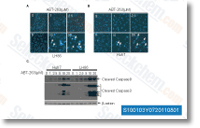Similar events have already been observed in allopolyploids of other species. It appears very likely hence that latest inter certain triploids have arisen from 1 or far more steps of blend and exchange of chromosomal seg ments in between the A and B genomes. Like a result, most if not all Musa cultivars most likely have ge nomes consisting of various proportions with the A and B genome. A related procedure of hybridization between subspecies of M. acuminata probably also underlines the evolution of the edible AA and AAA kinds. A conse quence of those recombination occasions is the hybrid genomes have an unbalanced number of A and B genome alleles. This plainly complicates genetic studies of trait inheritance, as well as the development and application of molecular marker technologies.
At the moment, over 90% of industrial export dessert ba nanas are created from selleck chemicals a single cultivar, namely Cav endish. Unsurprisingly, this dependency on a single cultivar as well as the consequent lack of genetic vari ation in production systems, has resulted inside a crop which can be potentially extremely prone to disorder pan demics. Pandemics are also not with no precedent in ba nana, and during the 1950s, Panama Disease brought about by the soil born fungus Fusarium oxysporum was accountable for fully wiping out industrial banana production, which at that time was dependent around the cul tivar Gros Michel. By necessity, Gros Michel was replaced by the Fusarium resistant cultivar Cavendish, but regrettably, inside the intervening many years new strains of F. oxysporum have evolved, that have conquer this pure Cavendish resistance.
At this time, another major dis ease threat is posed by Mycosphaerella fijiensis. Chemical handle of Fusarium wilt is ineffective, and in many cases though Black Sigatoka can be managed by fre quent fungicide applications annually, these are socio economically and environmentally inappropriate, and demand integrated tactics in order to avoid the advancement IKK-16 of fungicide  resistance within the pathogen. Consequently, there is certainly at present significantly curiosity in de veloping sustainable solutions to these disease threats through the introgression of novel resistance loci plus the development of new, disease resistant varieties. Nonetheless the largely sterile nature in the vast majority of business varieties signifies that banana breeding is each lengthy and time consuming. As a result the application of molecular marker technologies for that identification of trait marker associations, and higher throughput geno typing technologies can tremendously accelerate the entire breeding cycle as a result of marker assisted choice. Within this regard the recent publication of a large qual ity 523 Mb draft reference genome for that doubled hap loid genome of your wild M.
resistance within the pathogen. Consequently, there is certainly at present significantly curiosity in de veloping sustainable solutions to these disease threats through the introgression of novel resistance loci plus the development of new, disease resistant varieties. Nonetheless the largely sterile nature in the vast majority of business varieties signifies that banana breeding is each lengthy and time consuming. As a result the application of molecular marker technologies for that identification of trait marker associations, and higher throughput geno typing technologies can tremendously accelerate the entire breeding cycle as a result of marker assisted choice. Within this regard the recent publication of a large qual ity 523 Mb draft reference genome for that doubled hap loid genome of your wild M.
FAK signal
FAK is activated by focal adhesion complex
